S-type asteroids are the second-most common asteroids found throughout the Solar System. They are siliceous/stony mineralogical objects.
Key Facts & Summary
- S-type asteroids represent around 17% of all known asteroids in the solar system.
- Some of the biggest asteroids ever discovered belong to the S-type class of asteroids.
- Many S-type asteroids have similar compositions and spectral characteristics with certain meteorites.
- Based on their albedo, the majority of S-type asteroids are moderately bright.
- The brightest S-type asteroid, 7 Iris, is one of the brightest asteroids ever discovered.
- Most S-type asteroids are dominant in the inner part of the asteroid belt within 2.2 AU away from the Sun, and at 3 AU, they are still quite common.
- There are more than five sub-classes of S-type asteroids such as A-type, K-type, L-type, Q-type, and R-type.
- Some of the most numerous asteroid families are part of the S-type class.
- The second-largest near-Earth object is 433 Eros. It is an S-type asteroid with a mean diameter of 16.8 km / 10.4 mi.
- Eros is also the first asteroid from the Amor group to be discovered, and the first asteroid to be studied from orbit.
- Juno is the second most massive S-type asteroid. It only has 3% of Ceres’s mass.
- Juno’s spectral classification is S, and its apparent magnitude varies from 7.4 to 11.55. Thus, it is the brightest asteroid ever to be discovered after 4 Vesta.
The initial S- stands for siliceous. Such asteroids make up around 17% of all the known asteroids in the solar system. The term asteroids means starlike, since the first astronomers who studied them thought that they were stars.
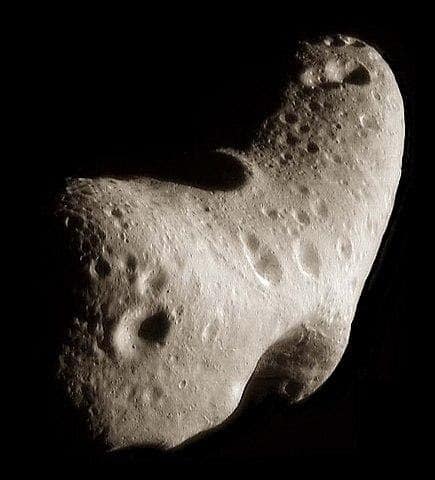
S-type asteroids are very similar in composition to a large variety of stony meteorites, which also share similar spectral characteristics. It is quite possible that these meteorites resulted from the collision of different s-type asteroids.
Formation
When the solar system was young, dust and rock were pulled together by gravity and gave birth to the first planets. Some of this debris, however, was left alone to orbit the Sun.
Later, between the regions of Mars and Jupiter, the asteroids were somehow brought together probably due to gravitational interactions with the giant planets and resulted in the now-famous asteroid belt.
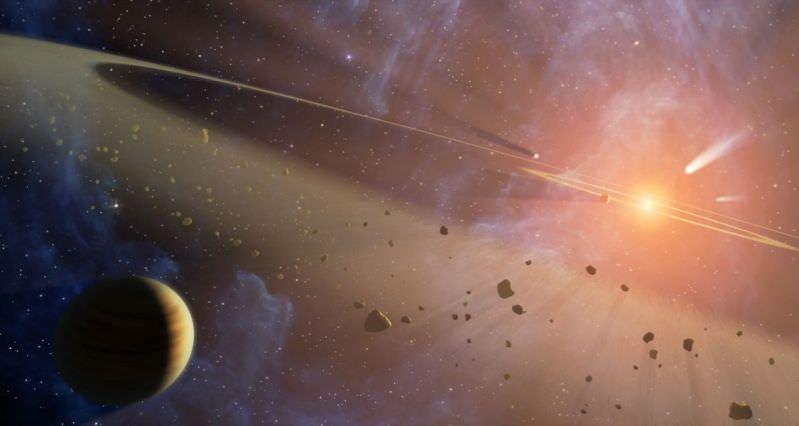
Many believe that these asteroids are remnants from a planet that was destroyed in a collision; however, the entire mass of the asteroid belt is too little actually to constitute that of a former planet.
Composition
S-type asteroids consist mainly of nickel-iron and magnesium-silicates/stony materials. They are moderately bright, having an albedo of typically 0.20.
Location
Most S-type asteroids are located in the inner asteroid belt within 2.2 AU away from the Sun, and common within 3 AU in the central belt. They become rarer and rarer the further out you go. Some of the largest s-type asteroids can be seen even with 10x50 binoculars.

Other Characteristics
Like other types of asteroids, s-type asteroids have different shapes and sizes. Most of them have irregular shapes. The s-type asteroids have spectral characteristics similar to many stony meteorites, but they also share a typical composition.
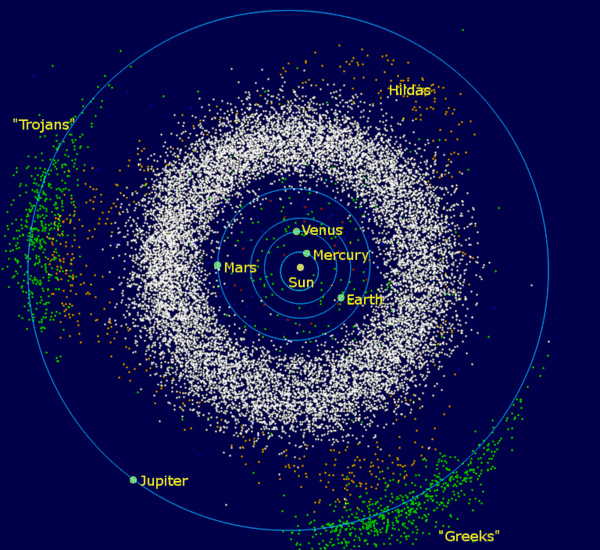
Their spectrum has a moderately steep slope at wavelengths shorter than 0.7 micrometers, and they also have moderate, weak absorption features around 1 and 2 micrometers.
The 1 micrometer is indicative of the presence of silicates / stony minerals. Quite often, there is also a broad but shallow absorption feature centered near 0.63 micrometers.
Classification
The SMASS classification provides us with several “stony” types of asteroids that are brought together into the wider S-group, which contains the following:
A-type – Relatively uncommon inner-belt asteroids but with strong, broad 1-micrometer olivine feature and a very reddish spectrum short wards of 0.7 micrometers.
K-type – Relatively uncommon asteroids with a moderately reddish spectrum short wards of 0.75 micrometers, and a slightly bluish trend long wards this, with low albedos. Spectrum type resembles that of CV and CO meteorites.
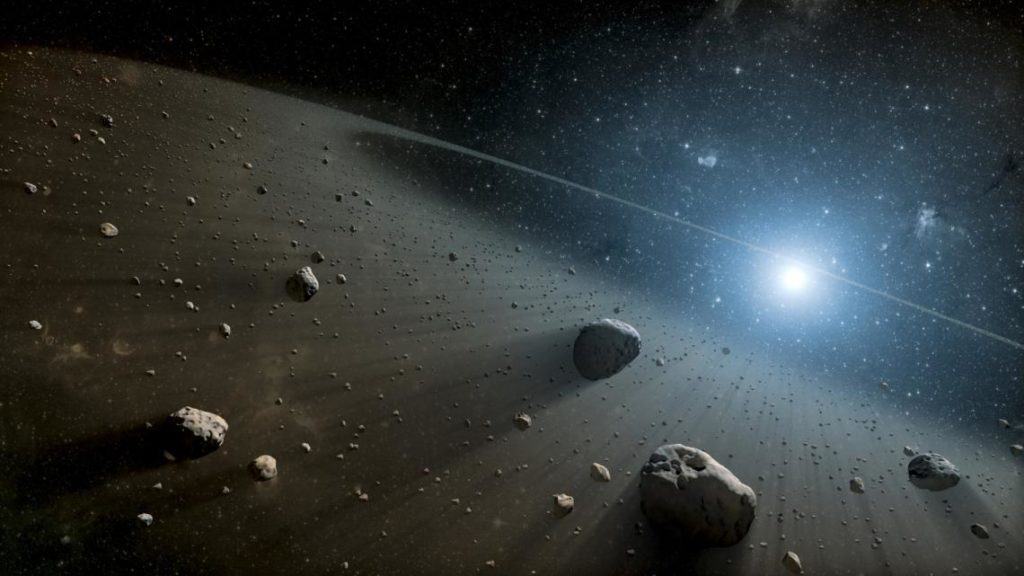
L-type- Relatively uncommon with a strongly reddish spectrum short wards of 0.75 micrometers, and a featureless flat spectrum long wards of this. In comparison with the K-types, L-types exhibit a more reddish spectrum and a flat spectrum in the infrared.
Q-type- Relatively uncommon inner-belt asteroids. They have a broad 1-micrometer olivine and pyroxene feature, and a spectral slope that indicates the presence of metal. There are absorption features short wards and long wards of 0.7 micrometers.
R-type- Moderately bright and relatively uncommon inner-belt asteroids that are spectrally intermediate between the V and A-type asteroids. The spectrum shows distinct olivine and pyroxene features at 1 and 2 micrometers, with a possibility of plagioclase.
Stony Asteroid Families
The most prominent stony asteroid families with their typical albedo are the:
Eos family – They have an albedo of 0.14. It is a large family of asteroids located in the outer region of the asteroid belt. The K-type asteroids are thought to have formed as a result of an ancient collision. The parent body is believed to be the asteroid 221 Eos.
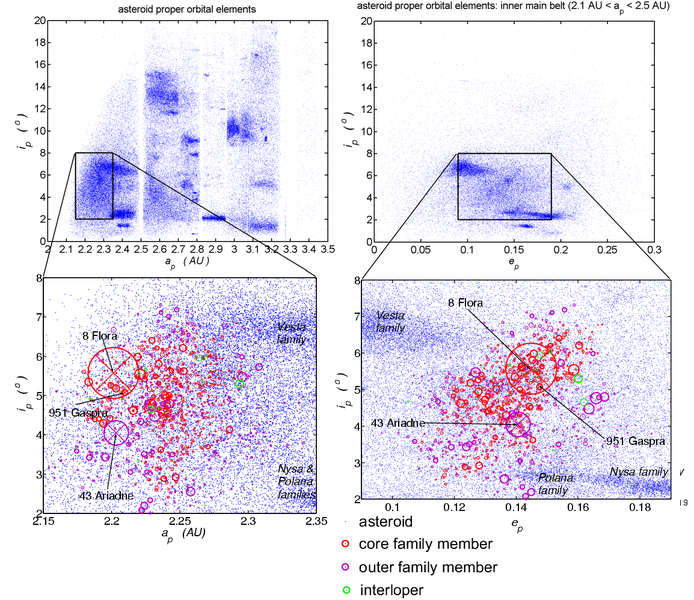
Eunomia family – Another numerous family with an albedo of 0.21. These S-type asteroids are named after their parent body, 15 Eunomia. This is the most prominent family in the intermediate asteroid belt and the 6th largest family with almost 6.000 members – this is the equivalent of 1.4% of all the asteroids in the asteroid belt.
Flora family – A prominent family of stony asteroids with an albedo of 0.24. It is located in the inner region of the asteroid belt. Again, one of the largest families with more than 13.000 members, or about 3.5% of all main-belt asteroids.
Koronis family – Also known as the Lacrimosa family – it is a large family of stony asteroids, located in the outer region of the asteroid belt. It is estimated that they formed around two billion years ago in a giant collision between two larger celestial bodies. They also have an albedo of 0.24.
Nysa family – It is part of the Nysa-Polana complex, the largest cluster of asteroid families in the asteroid belt. They have an albedo of 0.20. Located in the inner region of the asteroid belt, they orbit the Sun between 2.41 and 2.5 AU. The members of this family have orbit eccentricities between 0.12 and 0.21.
Phocaea family – This is a collisional family of asteroids located between 2.25 and 2.5 AU away from the Sun, in the inner region of the asteroid belt. They have an albedo of 0.23. Phocaea asteroids are S-type and have orbits with eccentricities higher than 0.1 and inclinations between 18 and 32 degrees. It is believed that the family formed around 2.2 billion years ago.
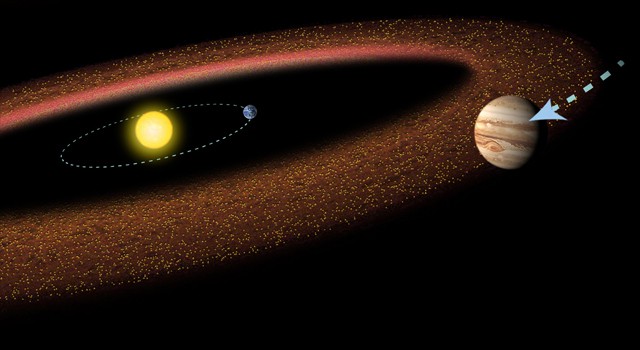
Examples of S-type Asteroids
Currently, the largest known S-type asteroid is 15 Eunomia. It has a diameter of 330 km / 205 mi. Following this, there is 3 Juno, with a diameter of 271.4 km / 168.6 mi, 29 Amphitrite with 200 km / 124 mi, 532 Herculina with 225 km / 139.8 mi, and 7 Iris with a diameter of 214 km / 132.9 mi.
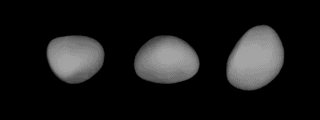
These giant S-type asteroids can be viewed with binoculars. The asteroid 7 Iris, can occasionally become brighter than +7.0, which is the highest magnitude of an asteroid except for the unusually reflective 4 Vesta.
The Future
Though S-type asteroids are the second-most numerous and have survived for millions of years, one day, the entire asteroid belt will be gone. This will happen when the Sun approaches the end of its life. The Sun’s powerful last light will shatter the asteroids with radiation.
Did you know?
- The S-type asteroid 15 Eunomia is one of the largest asteroids discovered. It is estimated to contain 1% of the total mass of the asteroid belt.
- Another S-type asteroid, 3 Juno, is the 11th largest and also contains 1% of the total mass of the asteroid belt.
- Some hypothesize that the asteroid belt is merely the remnants of a destroyed planet. However, the calculated remaining weight is not enough to support this.
Sources:
Image sources:
- https://upload.wikimedia.org/wikipedia/commons/thumb/e/e5/Eros_-_PIA02923_%28color%29.jpg/435px-Eros_-_PIA02923_%28color%29.jpg
- https://www.universetoday.com/wp-content/uploads/2009/10/icy-asteroid.jpg
- https://nineplanets.org/wp-content/uploads/2019/09/asteroid-belt.png
- https://upload.wikimedia.org/wikipedia/commons/thumb/f/f3/InnerSolarSystem-en.png/300px-InnerSolarSystem-en.png
- https://estaticos.megainteresting.com/media/cache/1140x_thumb/uploads/images/article/5e44fa105bafe855705468da/cinturon-de-asteroides_0.jpg
- https://upload.wikimedia.org/wikipedia/commons/thumb/9/90/Flora_family.png/694px-Flora_family.png
- https://cdn.arstechnica.net/wp-content/uploads/2020/02/pia16212-640.jpg
- https://upload.wikimedia.org/wikipedia/commons/thumb/8/8f/15Eunomia_%28Lightcurve_Inversion%29.png/320px-15Eunomia_%28Lightcurve_Inversion%29.png
